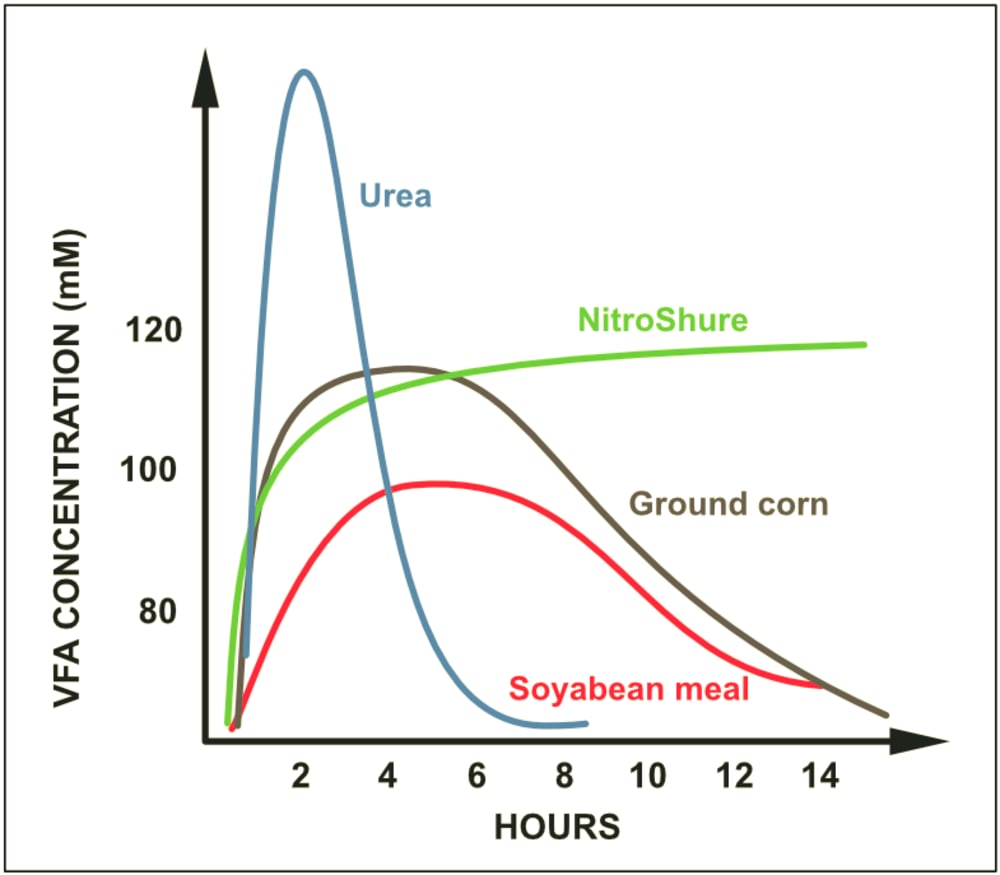Better balance between rumen energy and protein an opportunity to boost growth and margins
Published Thursday, 17th January 2019Faster growth and quicker finishing should be a top priority for beef producers this coming year, explains our EMEA Ruminant Technical Director, Dr Derek McIlmoyle. Not only does it maximise the gain achieved when cattle are at their most efficient and cut feed costs, but it also produces better quality meat.
“Feed efficiency declines as cattle get older, so the more gain you can make early on, the lower overall feed costs will be for a given slaughter weight,” he states. “If that faster growth can be achieved by improving rumen function, rather than buying additional feeds, then the benefits will be even greater.”
Improving feed conversion
Improving the efficiency with which feed is converted into growth is the key, with beef cattle typically averaging around 6.5kg of feed for each kg of liveweight gain (LWG).
“Anything that reduces this figure can have a dramatic impact on overall profitability,” Dr McIlmoyle continues. “Optimising rumen fermentation efficiency and the production of microbial protein is probably where most beef producers can have greatest impact.
“Microbial protein contributes up to two thirds of all the protein used by beef cattle and contains a nearly perfect mix of the amino acids needed to produce meat. If more microbial protein can be produced from the same feed consumed, either cattle can grow faster, or the amount of bought-in feed can be reduced.”
Greater fermentation efficiency
The rumen microbial growth that produces this protein can only be optimised, however, when the release of energy and protein in the rumen is properly balanced. If the energy released when the carbohydrates in the ration – sugars, starch and fibre – are fermented is out of balance with the supply of nitrogen from protein degradation, microbial growth will be compromised and some of those nutrients lost.
“Less microbial growth also means less fermentation activity, which slows feed passage through the rumen and cuts intakes, further reducing efficiency,” Dr McIlmoyle adds. “The key is to match the rate and extent of energy and protein breakdown to the needs of the microbes as closely as possible.
“In most rations, the main challenge is to provide enough rumen degradable protein (RDP), and hence nitrogen, to match the relatively rapid release of energy from starch. And it’s only by getting this right that the starch in the ration can be fully utilised, as well as the potential for acidosis (excess starch is converted into lactic acid) kept under control.”
Improving nitrogen supply
The addition of urea to rations has been a common way to improve RDP levels in the past, but the rate of breakdown in the rumen is too rapid to match the degradation of starchy feeds, resulting in much of the released nitrogen being wasted (see Figure 1). However, the latest controlled-release nitrogen sources like NitroShure are specifically designed to deliver nitrogen at a steady rate that much better matches the degradability of starch in the rumen
Figure 1 - Comparison of degradation rates in the rumen.
“This improved balance between energy and nitrogen release in the rumen can have a big impact,” Dr McIlmoyle continues. “For example, research studies have shown a 10% increase in dry matter and fibre digestibility when using NitroShure.
“It also allows ration starch levels of up to 25% without inducing acidosis, as well as reducing the amount of protein needed, which both cuts feed costs and creates extra space in the ration. This can be used to feed more energy for even faster growth, or allow more lower density – typically cheaper – forms of energy such as forages to be fed without reducing energy intake or cattle performance.
“Whichever way you look at it, the end result is more efficient growth and lower costs per kg of LWG. And that’s the key to better margins and better overall profitability.”
Latest news
Stay ahead with the latest news, ideas and events.

Online Feed Fibre Calculator
Calculate the percentage of dietary fibre in your feed
Our calculator is designed for nutritionists and uses averages of global raw materials to calculate the dietary fibre content (plus other more in-depth fibre parameters) of finished animal feed. These parameters are available within AB Vista’s Dietary Fibre analysis service (part of our NIR service).
Sign up for AB Vista news
A regular summary of our key stories sent straight to your inbox.
SUBSCRIBE© AB Vista. All rights reserved 2025
Website T&Cs Privacy & Cookie Policy Terms & Conditions of Sale University IDC policy Speak Up Policy

























